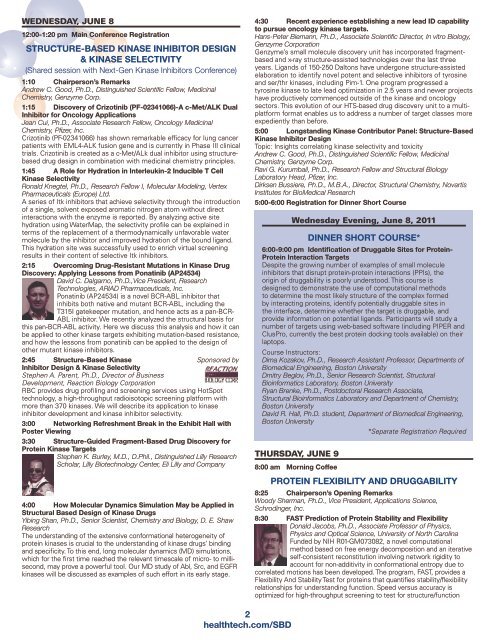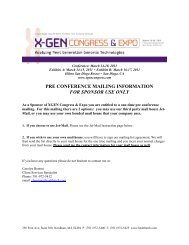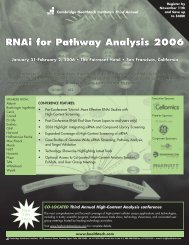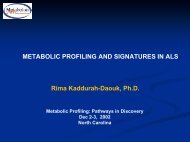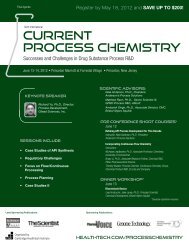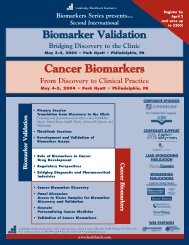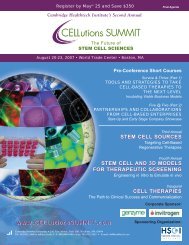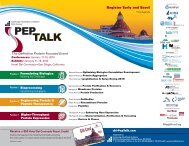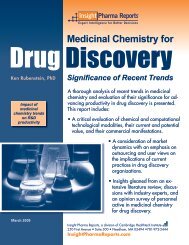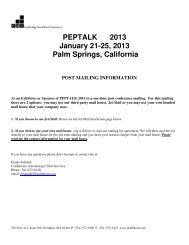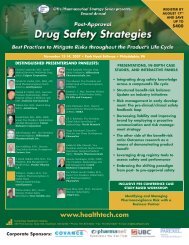Structure-Based Drug Design Conference Final Brochure.pdf
Structure-Based Drug Design Conference Final Brochure.pdf
Structure-Based Drug Design Conference Final Brochure.pdf
- No tags were found...
Create successful ePaper yourself
Turn your PDF publications into a flip-book with our unique Google optimized e-Paper software.
WEDNESDAY, JUNE 8<br />
12:00-1:20 pm Main <strong>Conference</strong> Registration<br />
STRUCTURE-BASED KINASE INHIBITOR DESIGN<br />
& KINASE SELECTIVITY<br />
(Shared session with Next-Gen Kinase Inhibitors <strong>Conference</strong>)<br />
1:10 Chairperson’s Remarks<br />
Andrew C. Good, Ph.D., Distinguished Scientific Fellow, Medicinal<br />
Chemistry, Genzyme Corp.<br />
1:15 Discovery of Crizotinib (PF-02341066)-A c-Met/ALK Dual<br />
Inhibitor for Oncology Applications<br />
Jean Cui, Ph.D., Associate Research Fellow, Oncology Medicinal<br />
Chemistry, Pfizer, Inc.<br />
Crizotinib (PF-02341066) has shown remarkable efficacy for lung cancer<br />
patients with EML4-ALK fusion gene and is currently in Phase III clinical<br />
trials. Crizotinib is created as a c-Met/ALk dual inhibitor using structurebased<br />
drug design in combination with medicinal chemistry principles.<br />
1:45 A Role for Hydration in Interleukin-2 Inducible T Cell<br />
Kinase Selectivity<br />
Ronald Knegtel, Ph.D., Research Fellow I, Molecular Modeling, Vertex<br />
Pharmaceuticals (Europe) Ltd.<br />
A series of Itk inhibitors that achieve selectivity through the introduction<br />
of a single, solvent exposed aromatic nitrogen atom without direct<br />
interactions with the enzyme is reported. By analyzing active site<br />
hydration using WaterMap, the selectivity profile can be explained in<br />
terms of the replacement of a thermodynamically unfavorable water<br />
molecule by the inhibitor and improved hydration of the bound ligand.<br />
This hydration site was successfully used to enrich virtual screening<br />
results in their content of selective Itk inhibitors.<br />
2:15 Overcoming <strong>Drug</strong>-Resistant Mutations in Kinase <strong>Drug</strong><br />
Discovery: Applying Lessons from Ponatinib (AP24534)<br />
David C. Dalgarno, Ph.D.,Vice President, Research<br />
Technologies, ARIAD Pharmaceuticals, Inc.<br />
Ponatinib (AP24534) is a novel BCR-ABL inhibitor that<br />
inhibits both native and mutant BCR-ABL, including the<br />
T315I gatekeeper mutation, and hence acts as a pan-BCR-<br />
ABL inhibitor. We recently analyzed the structural basis for<br />
this pan-BCR-ABL activity. Here we discuss this analysis and how it can<br />
be applied to other kinase targets exhibiting mutation-based resistance,<br />
and how the lessons from ponatinib can be applied to the design of<br />
other mutant kinase inhibitors.<br />
2:45 <strong>Structure</strong>-<strong>Based</strong> Kinase Sponsored by<br />
Inhibitor <strong>Design</strong> & Kinase Selectivity<br />
Stephen A. Parent, Ph.D., Director of Business<br />
Development, Reaction Biology Corporation<br />
RBC provides drug profiling and screening services using HotSpot<br />
technology, a high-throughput radioisotopic screening platform with<br />
more than 370 kinases. We will describe its application to kinase<br />
inhibitor development and kinase inhibitor selectivity.<br />
3:00 Networking Refreshment Break in the Exhibit Hall with<br />
Poster Viewing<br />
3:30 <strong>Structure</strong>-Guided Fragment-<strong>Based</strong> <strong>Drug</strong> Discovery for<br />
Protein Kinase Targets<br />
Stephen K. Burley, M.D., D.Phil., Distinguished Lilly Research<br />
Scholar, Lilly Biotechnology Center, Eli Lilly and Company<br />
4:00 How Molecular Dynamics Simulation May be Applied in<br />
Structural <strong>Based</strong> <strong>Design</strong> of Kinase <strong>Drug</strong>s<br />
Yibing Shan, Ph.D., Senior Scientist, Chemistry and Biology, D. E. Shaw<br />
Research<br />
The understanding of the extensive conformational heterogeneity of<br />
protein kinases is crucial to the understanding of kinase drugs’ binding<br />
and specificity. To this end, long molecular dynamics (MD) simulations,<br />
which for the first time reached the relevant timescale of micro- to millisecond,<br />
may prove a powerful tool. Our MD study of Abl, Src, and EGFR<br />
kinases will be discussed as examples of such effort in its early stage.<br />
4:30 Recent experience establishing a new lead ID capability<br />
to pursue oncology kinase targets.<br />
Hans-Peter Biemann, Ph.D., Associate Scientific Director, In vitro Biology,<br />
Genzyme Corporation<br />
Genzyme’s small molecule discovery unit has incorporated fragmentbased<br />
and x-ray structure-assisted technologies over the last three<br />
years. Ligands of 150-250 Daltons have undergone structure-assisted<br />
elaboration to identify novel potent and selective inhibitors of tyrosine<br />
and ser/thr kinases, including Pim-1. One program progressed a<br />
tyrosine kinase to late lead optimization in 2.5 years and newer projects<br />
have productively commenced outside of the kinase and oncology<br />
sectors. This evolution of our HTS-based drug discovery unit to a multiplatform<br />
format enables us to address a number of target classes more<br />
expediently than before.<br />
5:00 Longstanding Kinase Contributor Panel: <strong>Structure</strong>-<strong>Based</strong><br />
Kinase Inhibitor <strong>Design</strong><br />
Topic: Insights correlating kinase selectivity and toxicity<br />
Andrew C. Good, Ph.D., Distinguished Scientific Fellow, Medicinal<br />
Chemistry, Genzyme Corp.<br />
Ravi G. Kurumbail, Ph.D., Research Fellow and Structural Biology<br />
Laboratory Head, Pfizer, Inc.<br />
Dirksen Bussiere, Ph.D., M.B.A., Director, Structural Chemistry, Novartis<br />
Institutes for BioMedical Research<br />
5:00-6:00 Registration for Dinner Short Course<br />
Wednesday Evening, June 8, 2011<br />
Dinner Short Course*<br />
6:00-9:00 pm Identification of <strong>Drug</strong>gable Sites for Protein-<br />
Protein Interaction Targets<br />
Despite the growing number of examples of small molecule<br />
inhibitors that disrupt protein-protein interactions (PPIs), the<br />
origin of druggability is poorly understood. This course is<br />
designed to demonstrate the use of computational methods<br />
to determine the most likely structure of the complex formed<br />
by interacting proteins, identify potentially druggable sites in<br />
the interface, determine whether the target is druggable, and<br />
provide information on potential ligands. Participants will study a<br />
number of targets using web-based software (including PIPER and<br />
ClusPro, currently the best protein docking tools available) on their<br />
laptops.<br />
Course Instructors:<br />
Dima Kozakov, Ph.D., Research Assistant Professor, Departments of<br />
Biomedical Engineering, Boston University<br />
Dmitry Beglov, Ph.D., Senior Research Scientist, Structural<br />
Bioinformatics Laboratory, Boston University<br />
Ryan Brenke, Ph.D., Postdoctoral Research Associate,<br />
Structural Bioinformatics Laboratory and Department of Chemistry,<br />
Boston University<br />
David R. Hall, Ph.D. student, Department of Biomedical Engineering,<br />
Boston University<br />
*Separate Registration Required<br />
THURSDAY, JUNE 9<br />
8:00 am Morning Coffee<br />
PROTEIN FLEXIBILITY AND DRUGGABILITY<br />
8:25 Chairperson’s Opening Remarks<br />
Woody Sherman, Ph.D., Vice President, Applications Science,<br />
Schrodinger, Inc.<br />
8:30 FAST Prediction of Protein Stability and Flexibility<br />
Donald Jacobs, Ph.D., Associate Professor of Physics,<br />
Physics and Optical Science, University of North Carolina<br />
Funded by NIH R01-GM073082, a novel computational<br />
method based on free energy decomposition and an iterative<br />
self-consistent reconstitution involving network rigidity to<br />
account for non-additivity in conformational entropy due to<br />
correlated motions has been developed. The program, FAST, provides a<br />
Flexibility And Stability Test for proteins that quantifies stability/flexibility<br />
relationships for understanding function. Speed versus accuracy is<br />
optimized for high-throughput screening to test for structure/function<br />
2<br />
healthtech.com/SBD


